Welcome to Lesson 3 (Unit 1) of SKMLifestyle’s Chinese Language course. Have you ever wondered how to learn Chinese fast? Well, that’s the focus of this lesson for an efficient Mandarin Chinese learning. Again, I’d assume that you have read the previous lessons from Unit 1 (check out all lessons from Unit 1). I’ve also written some interesting background information about the Chinese language basics, please jump over to Unit 0.
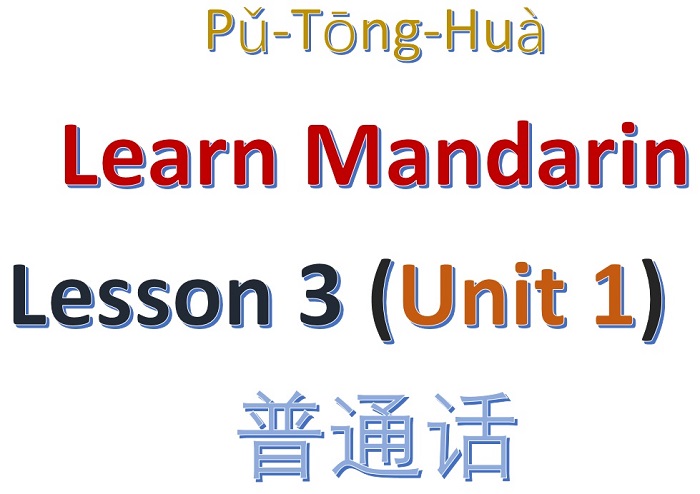
how to learn Chinese fast?
Learning a complex language like Mandarin Chinese indeed takes a lot of time. But you can play smart and learn efficiently. Although complicated, Mandarin is a beautiful language. I’m confident that if you streamline your Mandarin Chinese learning, you’d love the learning journey. For example, there are many characters that look similar, and may have connected meanings. In this lesson, I’d teach you some of the similar Mandarin characters, and we’d also learn the detailed meanings.
Similar characters for mandarin Chinese learning
In Mandarin Chinese, the character for eight is 八 (bā) – two slanted lines going apart from top to bottom without touching each other. If you join these two lines at the peak, you get a person (人, rén). The character for large (or big) is 大 (dà) – isn’t it looks like a tent? 🙂 If you place a small dot in the tent, you get too much (太, tài).
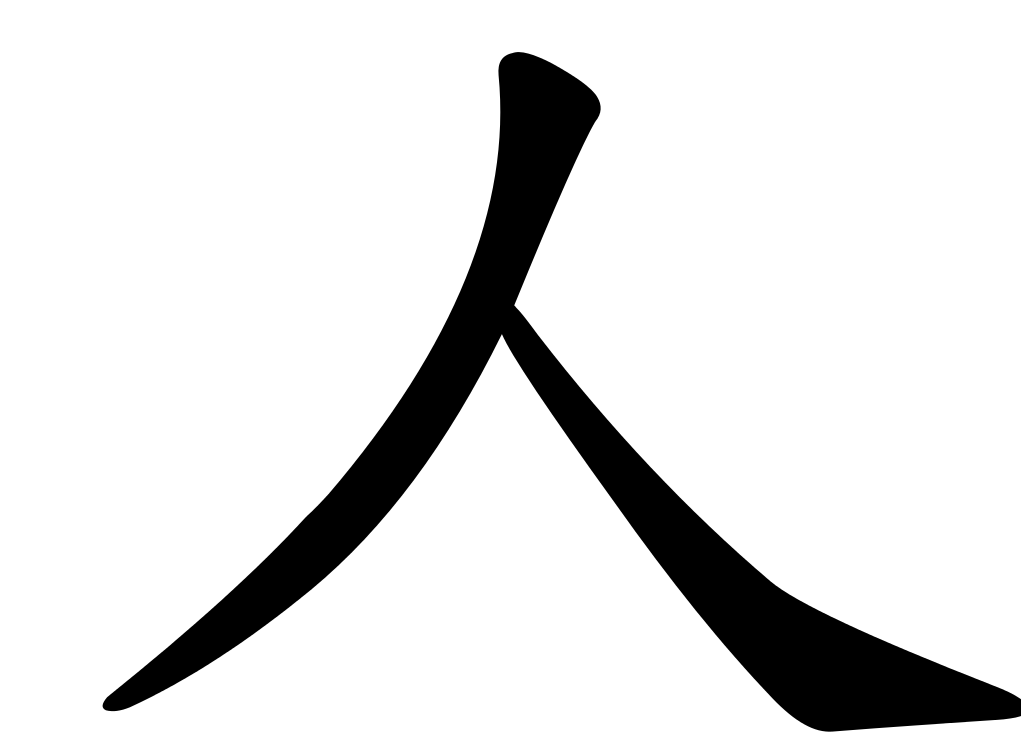
Everyone is denoted as 人人 (rén rén). An adult (unisex) is written as 大人 (dà rén).
Since the Mountain is written as 山 (shān), a big mountain could be denoted as 大山 (dà shān). Let me show you some more interesting Chinese characters (look carefully at them)-
- Death (亾, Wáng) – looks like a person (人) on a funeral pyre
- To follow, obey (从, Cóng) – 人 following 人
- Public (众, Zhòng) – 3 人 placed together (basically a crowd)
Fire – learn Chinese language
Adding two dots on person (人, rén) gives us the character for fire, which is denoted as 火 (huǒ). Now you can derive several characters and words- for example, inflammation is written as 炎 (Yán – two times 火), flames of fire 焱 (yàn – three times 火), strong fire 燚 (yì – four times 火). Forest fire is 山火 (shān hǔo). A big flame is written as 大火 (dà hǔo). Are you following me? Fire is indeed a very-very important word in the Chinese language. And I’ll tell you more about its usage in the coming lessons. Hold on for a while as I’ve got more interesting things to show you in this lesson.
husband & sky
By placing two horizontal lines on person (人, rén), you’d get the Chinese characters for husband and sky. The character for the sky is 天 (tiān) and the husband is written as 夫 (fū). Well, the difference between sky and husband characters is marked by the location of the upper horizontal line. For example, in the sky, the upper line is at the peak (天), in husband the upper line is placed slightly below the peak (夫). I’d simply put them together for a closer look: 天, 夫.
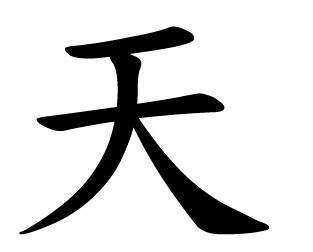
Btw, 天 (tiān) is another very important Mandarin Chinese character. It’s also used to denote a “day”. If you put two 天characters together, you’d get 天天 (tiān tiān) which means daily (or every day).
Chinese universities names
China being a huge country, there are thousands of universities across the nation. Can you guess how to write university in Mandarin? Well, you know the word for big (大, Dà). In Chinese, the character for learn (or college) is 学 (Xué). Now can you guess what does 大学 (DàXué) means? Well, it means university in Chinese, representing a “big college” or a “big learning center”.
The names of the several Chinese universities are based on the names of the corresponding cities. For example, I’ll show you the names of some of the Chinese cities, and the associated prestigious universities.
In the previous lessons (Lesson 1 and Lesson 2) of Unit 1, I taught you the names of these cities. So I’d safely assume that now you know how to write Suzhou (苏州, Sūzhōu), Guangzhou (广州, Guǎngzhōu), Hangzhou (杭州, Hángzhōu), Nanjing (南京, Nánjīng), etc.
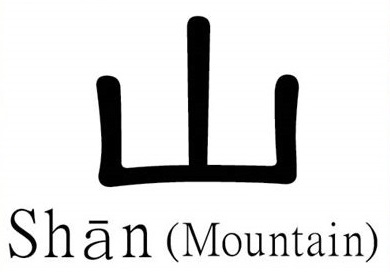
Can you guess how to write Suzhou University in Chinese? Well, you’d just combine the characters of a city’s name with the university (大学, DàXué). So Suzhou University can be written as 苏州大学 (Sūzhōu DàXué). I’d now directly write the names of other universities for a quick reference-
- Suzhou University (苏州大学, Sūzhōu DàXué).
- Guangzhou University (广州大学, Guǎngzhōu DàXué),
- Hangzhou University (杭州大学, Hángzhōu DàXué)
- Nanjing University (南京大学, Nánjīng DàXué)
How to learn Chinese fast? Shorten the names
I’ve noticed that the Chinese people often like to shorten the long words/sentences. For example, the names of the aforementioned universities are often abbreviated (even in the official usage). For example, the short name of Suzhou University (苏州大学, Sūzhōu DàXué) is 苏大 (SūDà).
If you take a ride on the Chinese bus, you’d often hear the announcements asking the passengers to get down at the next stop (similar to the subways). I live in Suzhou, and even in the public buses I hear “SūDà” on the Suzhou University’s adjoining bus stops.
Btw, Nanjing University (南京大学, Nánjīng DàXué) can be written as NánDà (南大).
Let me show you the NánDà (南大) bus stop in Suzhou (Nanjing University has a campus in Suzhou). I purposely went on a Sunday to click this photo to include in this lesson. 🙂

I wish to emphasize that you’d need to be careful about the abbreviated words. For example, NánDà (南大) can also represent a South University as south is written as Nán (南).
As another example, the Renmin University of China is also written as RénDà (人大). Let me show you the RénDà bus stop in Suzhou.
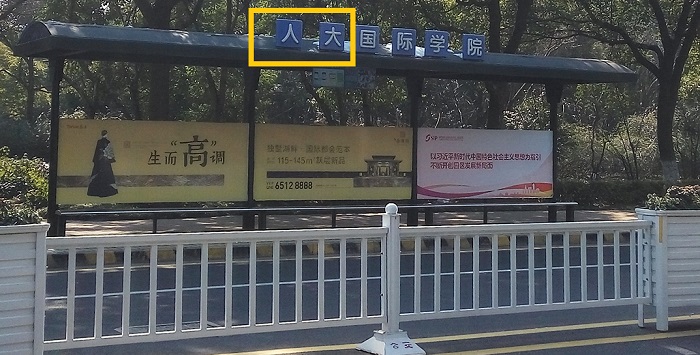
By now, you should have a better idea about how to learn Chinese fast. 🙂
That’s all in Lesson 3 of the Chinese Language course. Hope you have been following me all through the lessons. You can check out all lessons from Unit 1.
Feeling confident about the lessons? Cool! Try the Chinese Language Proficiency Test and see how much you now you know Mandarin Chinese. Be brave enough to not look at the answers before evaluating the questions (and of course deciding the answers). 🙂
You can also directly head to the next lesson of the Chinese Language course or check out the previous lesson again.
If you have any question or suggestions about Chinese language course, feel free to post in our forum so that others could also contribute and learn. For regular updates like us on Facebook, or follow on Twitter!
If you enjoy to learn Chinese language, or find the write-ups useful, don’t forget to buy me a beer!
Happy mandarin Chinese learning.
Last updated: Saturday, March 3, 2018